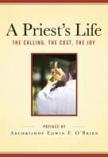In Faithful Service
This is a collection of reflections by 29 priests on the origins and meanings of their vocations. I use the plural deliberately because while there is a common theme in these short pieces, each man came to his vocation and finds sustenance in living it in ways that are uniquely his own. The book celebrates priesthood as a gift to the whole church. In their introduction, Patricia Mitchell and Jeff Smith, the president of The Word Among Us Inc., tell us “we wanted to compile these stories and witnesses to honor the many thousands of priests worldwide who serve us so selflessly.” They have succeeded admirably.
Along with the introduction, there is a preface by Archbishop Edwin F. O’Brien of Baltimore. The book concludes with the “Letter of His Holiness Pope Benedict XVI Proclaiming a Year for Priests.” Included among the reflections are two that deserve special mention. The first is an excerpt from a homily given to his priests by Cardinal Joseph Bernardin the evening before his installation as archbishop of Chicago. It is entitled “My Vision of the Priesthood.” The second is the homily Bishop Victor Galeone of the diocese of St. Augustine, Fla., gave to his priests in 2002 as the pedophilia scandal was breaking. Its title is “Celibacy: A Sign of Love for Jesus.” Read together these writings portray for me the beauty and the tragedy surrounding today’s priestly vocation.
Edited works are often uneven. But—whether because the reflections are brief or, more likely, because of the skill of Patricia Mitchell, who compiled them—these stories are consistently engaging. Some are funny; others poignant. All are worth reading. They tell of men working in missionary lands, in inner cities, in prisons, at ground zero in New York in 2001, doing scholarly research, teaching students in high school and graduate school, preaching and healing in charismatic ministries and suburban parishes. They are men looking back from 15, 30, 50 and more years after ordination. Some belong to religious orders; most are diocesan priests.
Several reflections reveal the deep friendships that these priests share with their brother priests. Some entered the seminary before high school and thus were part of cohorts that grew up together. In those days of large seminary classes, they could be sure that a fair number of them would continue to be nearby after ordination. One man related that his first assignment was to a parish where the pastor regularly invited neighboring priests for dinner. When the young priest was sent to another parish, he realized how much those dinners had influenced him. So, after calling his mother for some recipes, he began to invite the local clergy to dinner on a weekly basis. He cooked; others cleaned up. They spent the evening together, sharing stories that evoked laughter and sometimes chagrin. Soon they were supporting one another in practical ways: helping with penance services, Forty Hours devotion, etc.
As I read the account, I realized again, sadly, how much has changed. Seminaries today draw far fewer men, and they are older and come from dioceses across the country and around the world. After ordination few can expect to live within “dining” distance of classmates whose friendships will sustain them in their ministries.
As to the potential audience for this book, my first thought was of vocation directors who might give this paperback to men interested in pursuing a priestly vocation. Then my mind shifted to the audience who would benefit from reading A Priest’s Life. That audience is wider: all Catholics—and all fair-minded people—who are troubled by the seemingly unstoppable flood of stories of abuse and coverup. What a jolt of courage it is for our souls wearied by sorrow and betrayal to read about the chaplain whose service in Iraq ended when he suffered a brain injury that contributed to his death, or the missionary who shares the poverty of the people he serves, or the retired priest whose bed is his altar where he experiences the joy of “horizontal prayer.” For prayer is the common theme that threads through all the stories.
Prayer—sometimes deep, often fleeting, full of pain and grace, but more and more a constant companion—is what makes and keeps them good priests. This perhaps is the lesson they have to teach us.
This article also appeared in print, under the headline “In Faithful Service,” in the May 17, 2010, issue.








